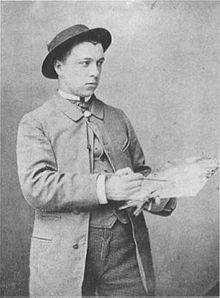Paul Signac
| Paul Signac | |
|---|---|

Paul Signac with his palette, ca. 1883
|
|
| Born |
Paul Victor Jules Signac 11 November 1863 Paris, France |
| Died | 15 August 1935 (aged 71) Paris, France |
| Nationality | French |
| Known for | Painting |
| Movement | Post-Impressionism, Neo-impressionism, Pointillism, Divisionism |
Paul Victor Jules Signac (French: [pɔl siɲak]; 11 November 1863 – 15 August 1935) was a French Neo-Impressionist painter who, working with Georges Seurat, helped develop the Pointillist style.
Paul Signac was born in Paris on 11 November 1863. He followed a course of training in architecture before deciding at the age of 18 to pursue a career as a painter after attending an exhibit of Monet's work. He sailed around the coasts of Europe, painting the landscapes he encountered. He also painted a series of watercolors of French harbor cities in later years.
In 1884 he met Claude Monet and Georges Seurat. He was struck by the systematic working methods of Seurat and by his theory of colors and became Seurat's faithful supporter, friend and heir with his description of Neo-Impressionism and Divisionism method. Under his influence he abandoned the short brushstrokes of Impressionism to experiment with scientifically juxtaposed small dots of pure color, intended to combine and blend not on the canvas but in the viewer's eye, the defining feature of Pointillism. Many of Signac's paintings are of the French coast. He loved to paint the water. He left the capital each summer, to stay in the south of France in the village of Collioure or at St. Tropez, where he bought a house and invited his friends.
Paul Signac, Albert Dubois-Pillet, Odilon Redon and Georges Seurat were among the founders of the Société des Artistes Indépendants. The association began in Paris 29 July 1884 with the organization of massive exhibitions, with the device "No jury nor awards" (Sans jury ni récompense). "The purpose of Société des Artistes Indépendants—based on the principle of abolishing admission jury—is to allow the artists to present their works to public judgement with complete freedom". For the following three decades their annual exhibitions set the trends in art of the early 20th century.
...
Wikipedia
